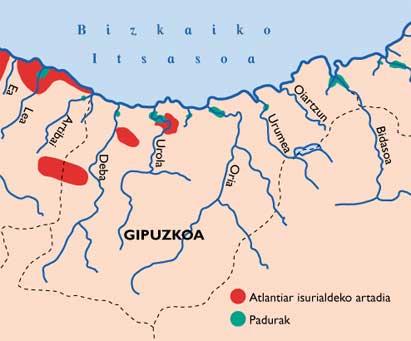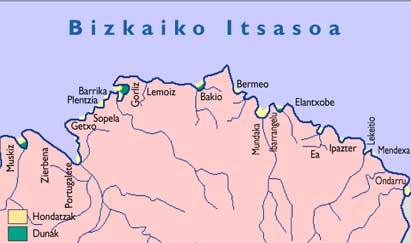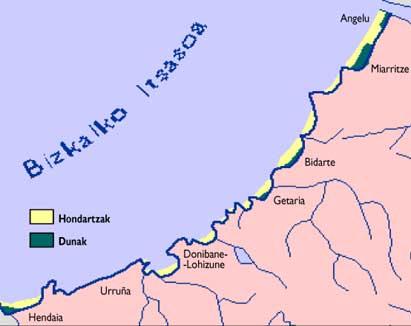Basque Coast (VI): Beaches of Gipuzkoa
1995/08/01 Estonba Mintxero, Mikel Iturria: Elhuyar aldizkaria
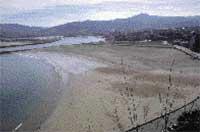
In the copies of May and June our readers were able to know the main ecological and geological characteristics of the beaches of Euskal Herria and the current state of the beaches of Lapurdi, respectively. This time it is the turn of the Gipuzkoans.
Gipuzkoa is not known for its beaches, its cliff coast leaves little space for the formation of this type of geomorphological elements, but has beautiful beaches in the rivers.
However, the strong growth of the population of this Territory in recent years has been noticed especially in coastal municipalities, has attacked its valuable ecosystems and beaches have not gotten rid of it. Let's analyze the situation of village to village beaches.
Hondarribia
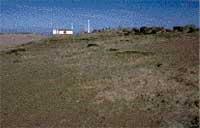
Although at the beginning of this century the English botanists emphasized the diversity and vegetable originality of the dunes of the beach of the bay of Hondarribia Txingudi, in the chronicles of the departure they made to study the vegetation of Euskal Herria, today there is nothing left of this ecological treasure, since the expansion of the village of Hondarribia and the channeling of the precious mouth of the river Bidasdoa
Instead, you can find the artificial beach that has currently formed next to the Hondarribia breakwater. This is more suitable for leisure than before, but from the ecological point of view it is quite poor. However, in recent years small dunes have formed on the right bank of the beach, where you can see some psammófila grasses. Further back, next to the car park located at the back of the beach, is an extensive wet meadow in which inhabits a large population of toad corridor (Bufo calamita) that can only be seen in Txingudi throughout Gipuzkoa.
Neither dunes nor toads live quietly. The first, in order for the City of Hondarribia to eliminate the "herbaceous" from the beach, since every year the Port Directorate of the Basque Government takes the vegetation out of the dunes to build a sports dock at the back.
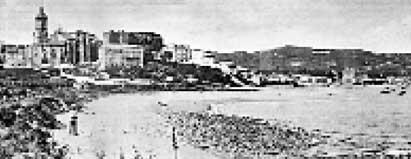
Donostia
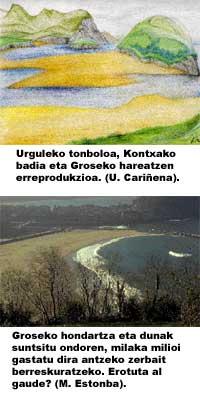
Although the fame of the capital of Guipuzcoa has had a great influence on its beach, the urban development that has been promoted in it, today is in a critical situation. It would be interesting to go back in history to better understand the origin of this troubling situation.
San Sebastián is built on the tombolo of the island of Urgul, on the sandy beaches of the bay and on the marshes of the rivers Urumea and Ibaeta. As the city has grown, the surroundings have been filling, so, in addition to reducing the marshes of the Urumea to minimums, the dunes of Gros and Ondarreta have disappeared and the highest beach of the Concha beach has remained under the asphalt, leaving the beach completely flooded during the days of live tide.
After this massacre, and in the name of the plans for the recovery of the beaches, they are promoting costly tasks of drag of sand to the beaches of Gros and La Concha and ecologically very critical, since the extraction of sand causes great damage to the marine ecosystems of soft bottoms, without taking into account that the solution is to develop a respectful urbanism with the environment.
Orio
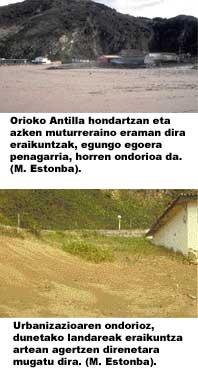
At the close intersection between the Talaimendi and Mendizorrotz mountains, the Oria River flows into the sea.
Today, although the problem is not solved, it can be observed that the estuary of Orio is channeled, which a few years ago has caused not only the drying of most of the marshes surrounding the village of Orio, but also important changes in its dunes.
However, the most damaging changes are those caused by man, since in the wonderful dune of the Oria the town hall of Orio has built camping, football field, gigantic parking and several bars, and the dunes and their vegetation have been reduced to small vestiges that have been isolated between the buildings.
On the left bank of the Ria del Oria, behind Talaimendi, we find the wonderful beach of Oribarzar. On this beach there was a military camp. It currently has a hostel of the Provincial Council of Gipuzkoa. However, even though these constructions and the bridge of the Bilbao-Behobia motorway have blinded the environment a lot, this beach remains quite well.
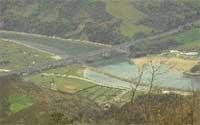
Zarautz
Zarautz is undoubtedly the longest beach in Gipuzkoa. Its origin was the sand deposit that closed the bay open to the sea in the Zarautz area. But today its width is small, as Zarautz has been built and extended over the dunes.
From the ecological point of view, the most important thing is the right bank of the beach, where in addition to the marsh of the river Inurritza and its mouth without pipes, there is the most fun and wide representation of the psammófila flora of Gipuzkoa in the golf course and in the dunes that have remained in its facade.
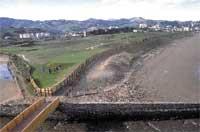
However, the duration of this dune piece is very insecure, to the beating that involved the construction of the golf course, has been added the strong erosion that the sea produces in the dunes during storms and the enormous human influence.
At this time, as a continuation of the Zarautz promenade, MOPTMA has installed wooden platforms in the dunes of Zarautz. These works have their advantages and disadvantages. On the one hand, the golf course has removed a piece to make the walk, which will probably result in a smaller footstep of the dunes. In addition, the dunes have been closed in order to prevent the passage of people and the Izadi Group of Zarautz is replanting dunes. This is the first case in the whole of Euskal Herria. But, on the other hand, it cannot be denied that the construction of the walk will contribute to increase human influence, which can harm the dunes of Zarautz.
In order to avoid the problem, the Izadi Group of Zarautz, with the collaboration of the City Council, has installed in its environment several information panels so that people respect such an important environment from the ecological point of view.
Getaria
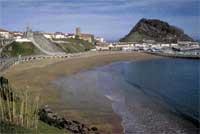
In Getaria there are two small beaches on each side of the isthmus that connects Mount San Anton with the dry. To the right is the beach of Malkorbe, originated by the construction of the dikes of the port of Getaria. This small artificial beach does not offer adequate conditions for the creation of dunes, so its importance from the ecological point of view is not significant.
Gaztelape beach is on the left of the isthmus and is a beach open to the sea. This beach, born in the massif, is not exclusive to sand, but also gravel. Its structure does not currently have dune development capacity.
Zumaia
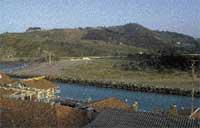
Municipality built in the ria del Urola, with two types of beaches. On the one hand, the wonderful beach of Santixo, of baroque and sandy origin, which usually appears at the mouth of the rivers, and on the other, originating from the spectacular cliffs that lie between Zumaia and Deba.
Santixo beach is divided by the house of the painter Zuloaga, from the beautiful marsh of Santixo, which is about to disappear because right now they want to build a sports pier. On this beach you can see magnificent dunes like those of Zarautz. In these dunes, despite the strong human pressure, it is preserved quite well and different parts of the dunes can still be distinguished.
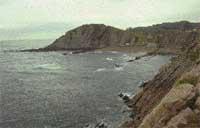
Of other beaches, only that of Itzurun will be mentioned in this article, since the rest will be mentioned when analyzing the cliffs of Euskal Herria. Itzurun beach is located at the foot of the cliffs at the bottom of the village of Zumaia, and due to its location and width does not have dune structure. Its value lies in the cliffs that surround the beach. But about that, as we said before, we'll talk in another article.
Deba
At the mouth of the river Deba there are two beaches. On the right bank, witness of the bar that originated in the estuary of the Deba before its channeling, the beach of Deba. This large beach, which in its day would have magnificent dunes, has been destroyed by the expansion of the village of Deba, the railways and the works made on the highest beach to strengthen tourism.
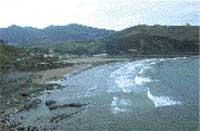
To the left of the mouth is the Ondarbeltz beach of Mutriku. This beach of little ecological value was originated by the spike built on the left bank for the channeling of the river. It witnesses the population of the Deba River and, as its name suggests, has a dark sand.
Mutriku
On the grounds of Mutriku, in addition to the aforementioned beach of Ondarbeltz, there are three others. Two of them are located under the cliffs of Galdonamendi, one next to the port of Mutriku and the other, called the westernmost Old Town. Due to the amount of stones this small and dangerous beach has, the locals claim that it is made up of seven smaller beaches, hence its name.
But the third is certainly the most interesting. We talked about Saturraran beach. This wonderful beach, located at the end of the river Saturraran and to the right of the bay of Ondarroa, has lost in recent years its main ecological values. In the channeling of the mouth of the river its small marsh was destroyed. On the other hand, the construction and human intervention that have risen at the back of the beach has limited the old beach dunes to small vestiges.
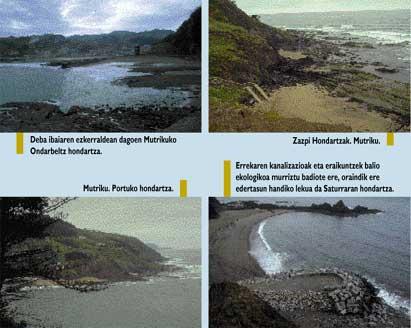
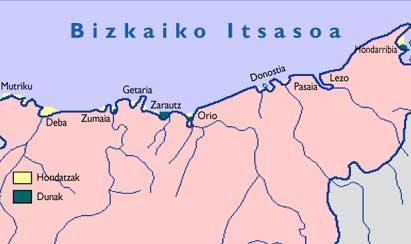

Gai honi buruzko eduki gehiago
Elhuyarrek garatutako teknologia




